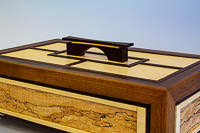- Woods Used: black palm, spalted maple, pink ivory
- Size: 12" x 8-1/2" x 3"
- Storage: Jewelry, keepsakes, etc.
- Price: $775
Karen is an avid gardener.
I’m not but I do try to help, “construction coordinator” to her “landscape designer”. This is how we spend much of our time – planting, tending, arranging, maintaining,
cleaning, building. An endless project. "Nothing lasts, nothing’s finished, nothing’s perfect” is never more evident than in the life of a groundskeeper.
We're lucky to share interests like gardening - frameworks of communication scaffolding our lives - and we’ll probably continue until we’re no longer able...
These boxes were built to display a particular piece of spalted maple. I just felt that it should be seen, this piece, these scapes, three times, in a dark frame (chocolate black palm, shocking pink ivory), in a medium tone frame (simple oak, simple ebony), and in a light frame (unblemished holly and formal imbuia).
Usually, I finish the pieces of my boxes before gluing them up, and do that just because it’s easier.
These particular boxes, however, due to their specific construction, do not really need to be “glued up” at
all since the pieces lock together. The captured through lap joint, in these proportions, provides for an extremely
rigid structure. For me, it’s (very loosely) reminiscent of the fact that traditional Chinese furniture was often done without glue.
- Woods Used: white oak, spalted maple, ebony
- Size: 12" x 8-1/2" x 3"
- Storage: Jewelry, keepsakes, etc.
Fascinating.
Of course, the idea is to always use the right amount of glue, "as little as possible" or "only where necessary". You should always have a little "squeeze-out" after clamping, but not too much -
the joint will be "glue starved".
And what about the glue itself? Gap-filling to make up for mistakes? Flexible to deal with time? Or hide glue, which is reversible.
Reversible?!
Then the squeeze-out is an issue: with a wet rag immediately or wait until later to pop it off with a chisel? (Both much easier to do if you finish the pieces a bit before.)
But that all begs the question: What about no glue? Could those pieces in " Chinese Domestic Furniture " really have been done with no glue? How could they have been so tight? How could they remain tight over the years?
Maybe a very delicate application of pressure would hold constructions together perfectly. Locking joints, keys, sensitive ratios - ((length vs. thickness)/experience) - creating subtle spring mechanisms, enforcing structure.
Sprung. Moving together. Dancing.
- Woods Used: imbuya, holly, spalted maple
- Size: 12" x 8-1/2" x 3"
- Storage: Jewelry, keepsake. Currently, has rudimentary interior partioning which can be customized to suit
- Contact me re: price & availability
If you look at that wonderful table on the cover of "Chinese Domestic Furniture" - an astonishing display of craft - and imagine that there’s no glue used to hold it together, then you might as well
imagine those carved apron pieces, with all their attendant joinery, being just the least bit too long, so as to create some ever-so-slight tension when forced into position, and that tension held in place
by locking the apron pieces with a slotted wooden key just behind where they meet, so that pulling them back toward the center of the structure as you enter them, and closing the key,
results in a very slight pushing out against the leg, and that this tiny force is applied to both sides of the leg, which combined with the fact that the leg, itself, is jointed
into the top and that if this joint is ever so slightly skewed toward the outside of the table the result is a counter force to the horizontal push being applied by the apron, thereby "locking" the joints, and the legs, and the table into integrity.


So then how much, (really, how little), should that little extra bit of length be? Different for each wood, each piece of wood, depending on its flexibility/stiffness, age, regularity of its growth and growth rings.
The weather it endured growing up...